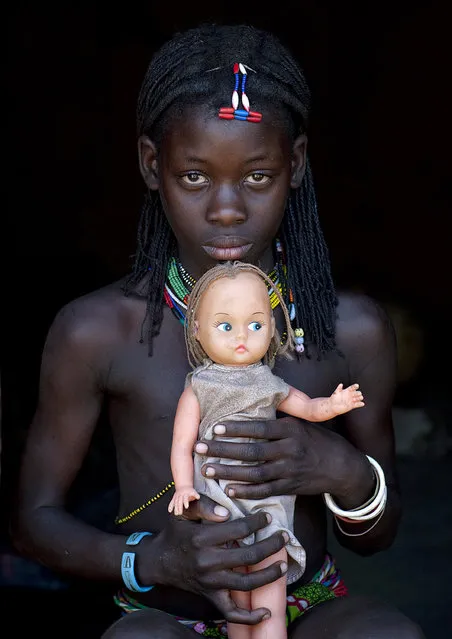
“The Muhacaona doll – Angola. In Soba village, the Muhacaona (Mucawana) tribe girl. This little girl had a doll, perhaps some tourists who gave her, as there are no shops arounds! The funny thing: she has made dreadlocks on the blue eyed doll, to make her look like herself!”. (Photo and comments by Eric Lafforgue)
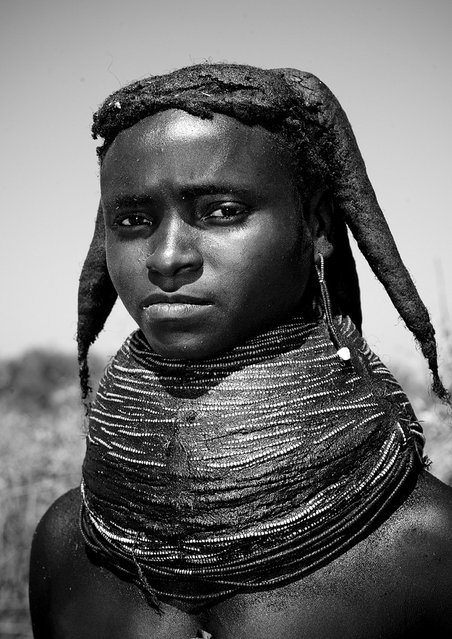
“Mwila tribe girl – Angola. Mwila (or Mwela, Mumuhuila, or Muhuila) women are famous for their very special hairstyles. Hairstyles are very important and meaningful in Mwila culture. Women coat their hair with a red paste called, oncula, which is made of crushed red stone. They also put a mix of oil, crushed tree bark, dried cow dung and herbs on their hair”. (Photo and comments by Eric Lafforgue)
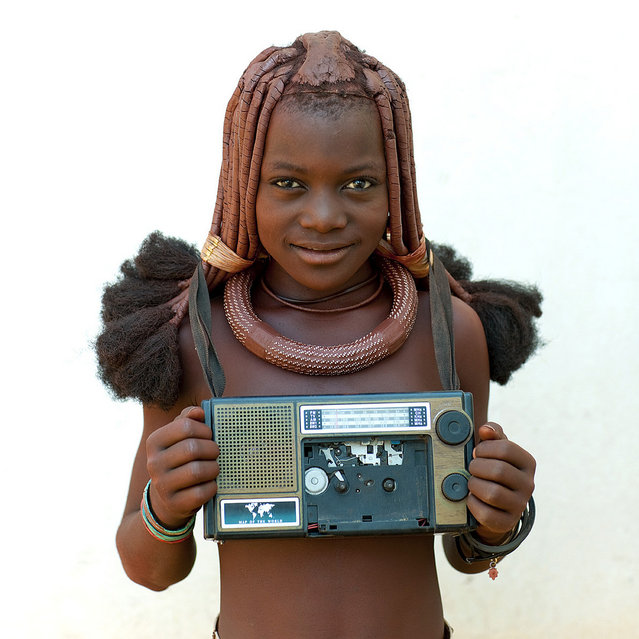
“Himba girl with her radio – Angola. She was walking with her radio around the neck. The tape was broken, but the radio was still working. In the same time, we queue for Ipad, iphod, iphone!”. (Photo and comments by Eric Lafforgue)
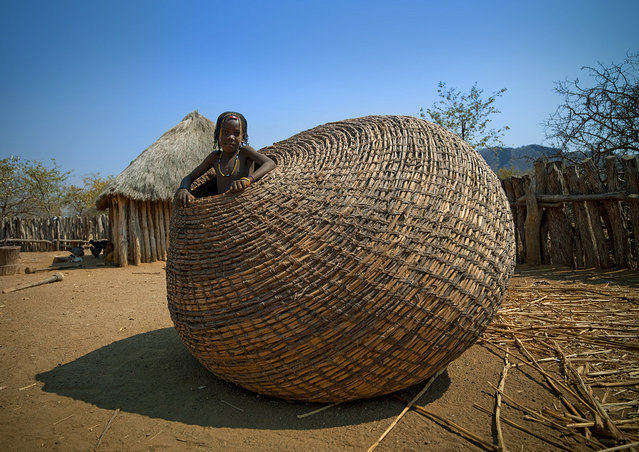
“Mundimba tribe girl in giant basket – Angola. Those giant baskets are used to keep the grains in Mundimba tribe, in south Angola.
The little girl wanted a picture inside, and jumped. But... there was already a goat sleeping in the shadow of the basket inside!”. (Photo and comments by Eric Lafforgue)
The little girl wanted a picture inside, and jumped. But... there was already a goat sleeping in the shadow of the basket inside!”. (Photo and comments by Eric Lafforgue)
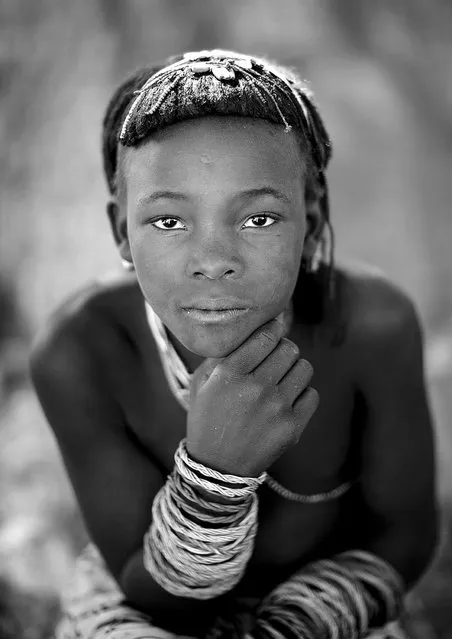
“Mucawana girl – Angola. Muhacaona (Mucawana) tribe girl. The haircut is made with a mix of cow dungs, fat, and herbs for the fragrance. She also wears some bracelets made with ropes”. (Photo and comments by Eric Lafforgue)
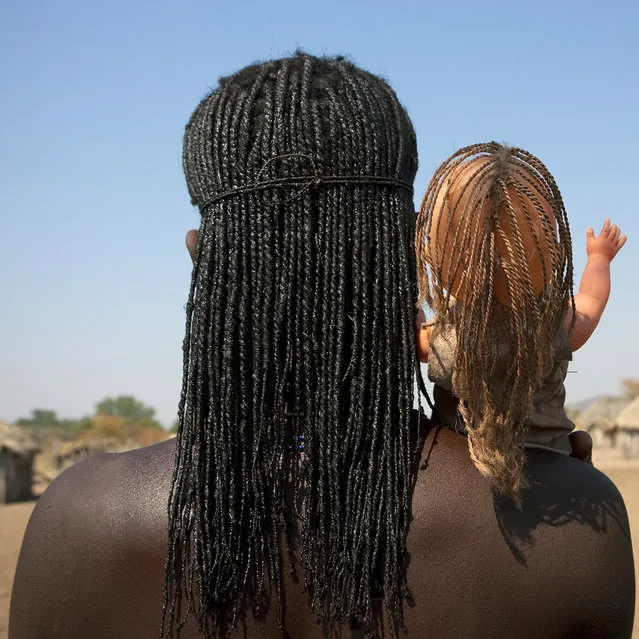
“Mucawana girl and doll – Angola. This Mucawana girl has made the same hairstyle to her white skin doll! They have only one doll in the village, and the toy is shared by every kid. Great lesson of solidarity and life”. (Photo and comments by Eric Lafforgue)
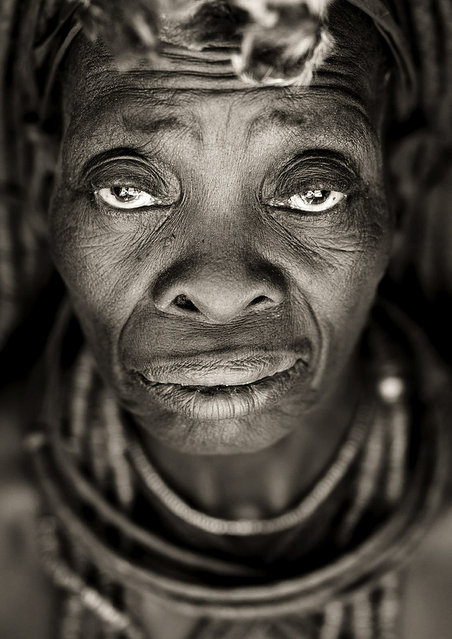
“Old Himba woman face – Angola. Old Himba woman in Angola, not the kind of ones you see in Namibia going to supermarket, and buying beers, but living in remote place, in south Angola, far from modern world, keeping their traditions strongly”. (Photo and comments by Eric Lafforgue)
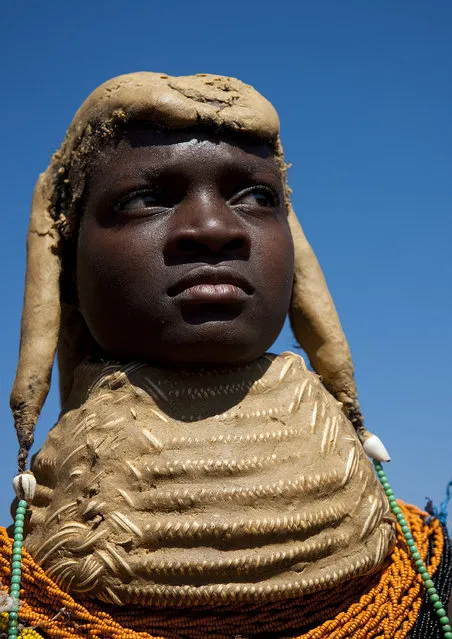
“Mumuilas tribe girl with her necklace – Angola. This tribe is one of the most beautiful i've seen: Mumuilas (or Muhilla ) live in south Angola, and are very shy with foreigners, as they do not see any tourists in the area! The girl on the picture wears a giant necklace made of hundreds of little necklaces of beads and ostrich eggs, and everything is covered with a mix of mud, cow dungs, and herbs to give a nice perfume. The girl wears this huge necklace as she has entered a new age category. She will keep it for years night and day, before being married. On her hair, the same mix!”. (Photo and comments by Eric Lafforgue)
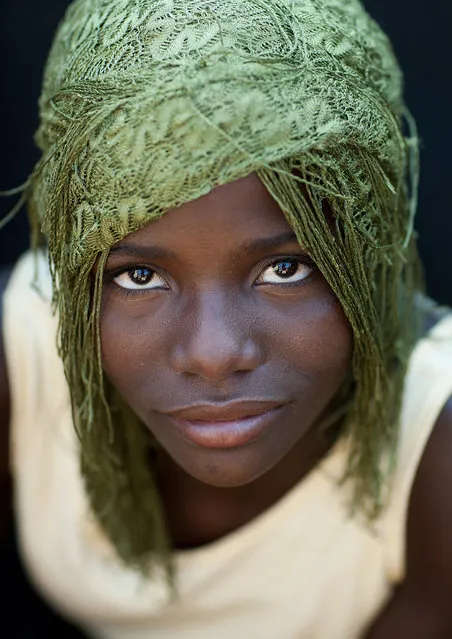
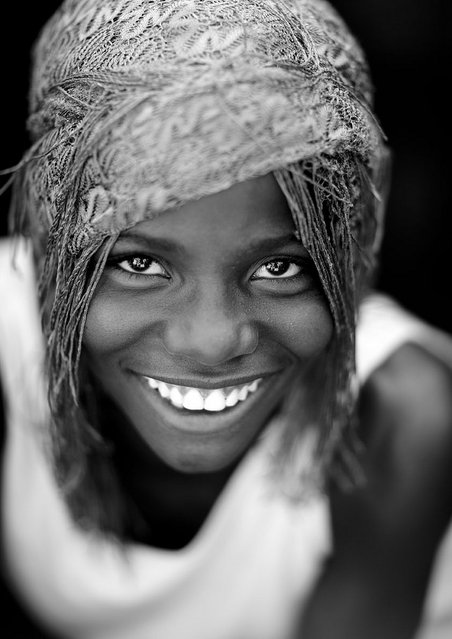
“Caroline, Mudimba girl smile – Angola. Mudimba young girl dressed for a wedding. Most of the women were wearing some clothes as it was a christian wedding, but some stayed in their tribal clothes: topless!”. (Photo and comments by Eric Lafforgue)
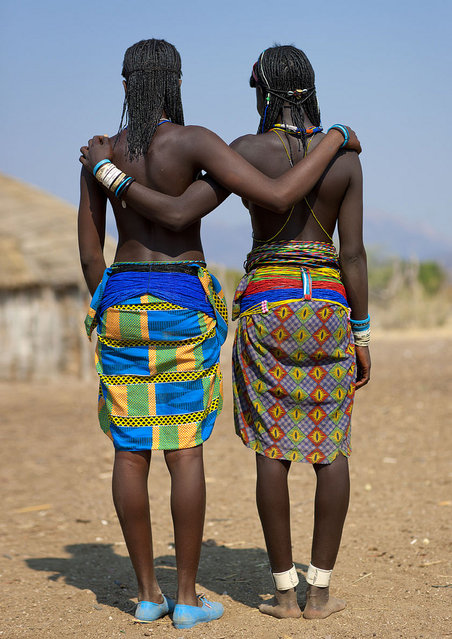
“Show us our butts! Mucawana tribe – Angola. In Soba village, the Muhacaona (Mucawana) tribe, perhaps the best place i have visited. They use cow dung and fat to make this so nice haircut, and love the beads. They asked me to make pictures of their backs... and butts to see on the camera screen if everything was perfect!”. (Photo and comments by Eric Lafforgue)
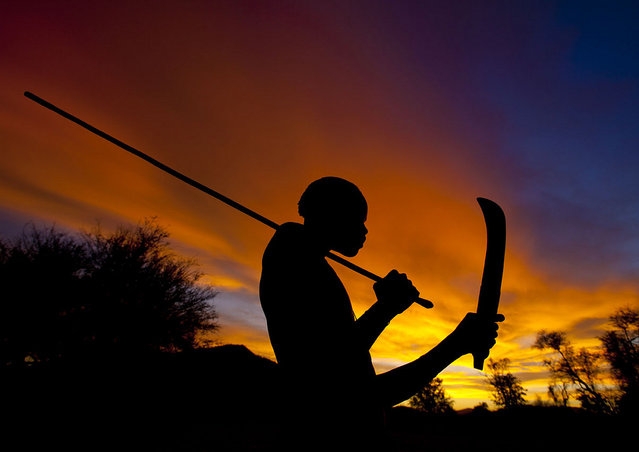
“Sunset in Mucubal tribe – Angola. I stayed in the Mucabale tribe several days, and had a really nice time with them. They are nice people, cool, and enjoyed to come to watch during hours what we did in the camp, even when we were just resting or reading a book!
On the picture, a Mucabale man. He was mentally affected, and acted like a kid of 6 even if he was 20. But the great thing is that when i wanted to take this picture with the shadow in front of the sunset, he was the only one to understand what i needed, and the other Mucable men were very surprized to see him acting so well! The big knife he holds is the weapon Mucabale never leave! The stick is mainly used to carry a cloth they wear when the rain falls. Mucubal (also called Mucubai, Mucabale, Mugubale) people are a subgroup of the Herero ethnic group, which means they are bantu speaking, and are supposed to have come from Kenya and to be related with Massais”. (Photo and comments by Eric Lafforgue)
On the picture, a Mucabale man. He was mentally affected, and acted like a kid of 6 even if he was 20. But the great thing is that when i wanted to take this picture with the shadow in front of the sunset, he was the only one to understand what i needed, and the other Mucable men were very surprized to see him acting so well! The big knife he holds is the weapon Mucabale never leave! The stick is mainly used to carry a cloth they wear when the rain falls. Mucubal (also called Mucubai, Mucabale, Mugubale) people are a subgroup of the Herero ethnic group, which means they are bantu speaking, and are supposed to have come from Kenya and to be related with Massais”. (Photo and comments by Eric Lafforgue)
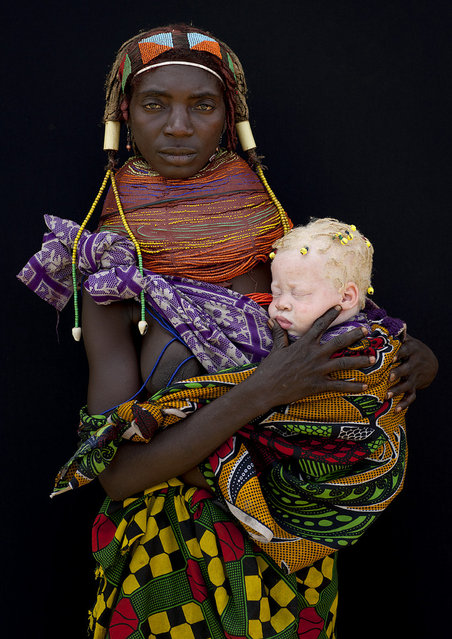
“Albino baby girl and her Mwila mother – Angola. This mwila tribewoman was in Hale and came to me, showing a blue cap coming out from her clothes. i first did not understood there was a baby under this cap. Then she opened her clothes to let appear this albino baby girl. She had some little dreadlocks and was incredibly white. The mother was proud to pause for the picture and discovered the magic of polaroid! I have seen many albinos people in Angola, in the tribes. They are mainly in very bad health, as the sun is very hot there... Perhaps the most moving picture i ever took as the future of this albino baby is not the happiest you can get in this remote area of Africa”. (Photo and comments by Eric Lafforgue)
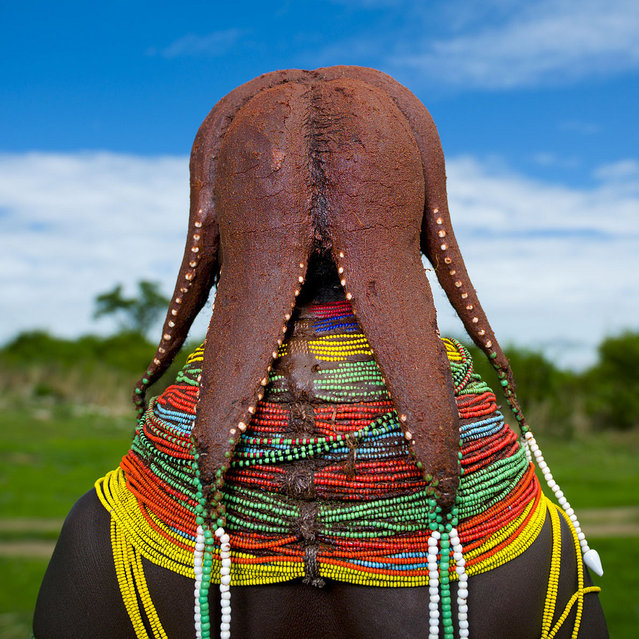
“Paul the Octopus haircut in Mwila tribe – Angola. Mwila (or Mwela, Mumuhuila, or Muhuila) women are famous for their very special hairstyles. Hairstyles are very important and meaningful in Mwila culture. Women coat their hair with a red paste called, oncula, which is made of crushed red stone. They also put a mix of oil, crushed tree bark, dried cow dung and herbs on their hair.
Besides they decorate their hairstyle with beads, cauri shells (real or plastic ones) and even dried food. Shaving the forehead is considered as a sign of beauty. The plaits, which look like dreadlocks, are called nontombi and have a precise meaning. Women or girls usually have 4 or 6 nontombi, but when they only have 3 it means that someone died in their family. Mwila Women are also famous for their necklaces, which are central and meaningful as for each period of their life corresponds a specific type of necklace. Young girls wear necklaces, heavy red made with beads covered with a mix of soil land latex. Later girls wear yellow necklaces called, Vikeka, made with wicker covered with earth. They keep until their wedding which can last 4 years. When married they start to wear a set of stacked up bead necklaces, called Vilanda. Women never take their necklace off and have to sleep with it. They also use headrests to protect their hairstyles.
However, more and more men and women dress in a western way, because people make fun of them when they go to markets. Women sometimes walk 50 kilometers to sell goods in Huila market. Mwila rarely eat meat, they rather eat porridge, corn, chicken, honey and milk. They kill their cattle only on special occasions. Mwila are not allowed to mention people’s name in public”. (Photo and comments by Eric Lafforgue)
Besides they decorate their hairstyle with beads, cauri shells (real or plastic ones) and even dried food. Shaving the forehead is considered as a sign of beauty. The plaits, which look like dreadlocks, are called nontombi and have a precise meaning. Women or girls usually have 4 or 6 nontombi, but when they only have 3 it means that someone died in their family. Mwila Women are also famous for their necklaces, which are central and meaningful as for each period of their life corresponds a specific type of necklace. Young girls wear necklaces, heavy red made with beads covered with a mix of soil land latex. Later girls wear yellow necklaces called, Vikeka, made with wicker covered with earth. They keep until their wedding which can last 4 years. When married they start to wear a set of stacked up bead necklaces, called Vilanda. Women never take their necklace off and have to sleep with it. They also use headrests to protect their hairstyles.
However, more and more men and women dress in a western way, because people make fun of them when they go to markets. Women sometimes walk 50 kilometers to sell goods in Huila market. Mwila rarely eat meat, they rather eat porridge, corn, chicken, honey and milk. They kill their cattle only on special occasions. Mwila are not allowed to mention people’s name in public”. (Photo and comments by Eric Lafforgue)
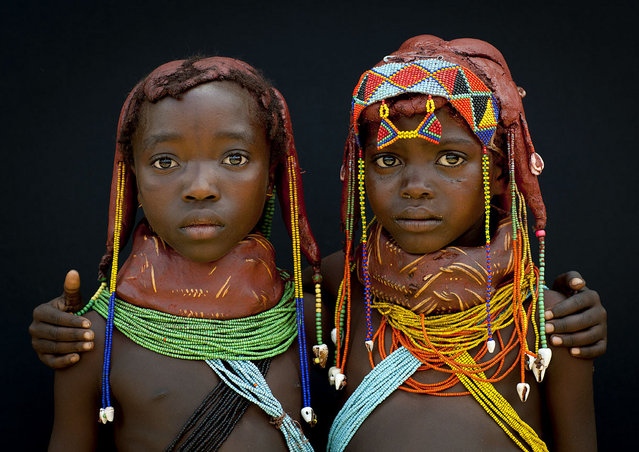
“Two Mumuhuilas little girls – Angola. Those little girls from the Mumuhuila tribe live near Chibia, in the south of Angola. They wear the traditional hairstyle and the big necklace. The necklace shows if they are teens or not. They still are children as the necklace is red. On their hair, they wear the traditional hairstyle, made with a mix of trunk, oil and cow dung. It was impossible to make them smile as pausing for a white man was too impressive for them, it was the first time they met tourist. Imagine the face they had when i gave them a polaroid at the end of the session! Those little girls live dressed like that, they were not dressed for me”. (Photo and comments by Eric Lafforgue)
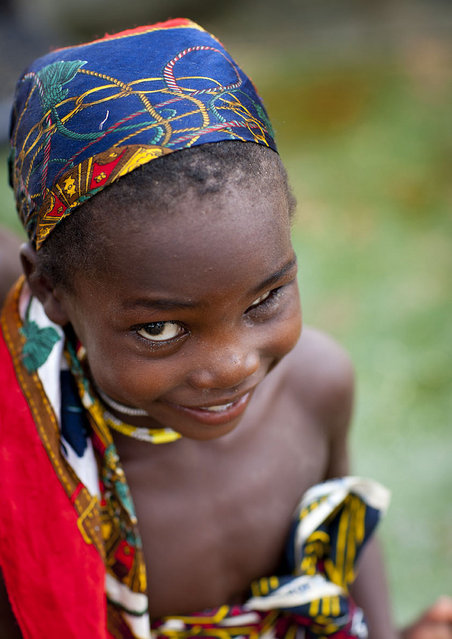
“Smiling one eyed Mucubal girl – Angola. She was so happy to have attention from a white man, and so happy to be , like the others, the model for him! So many problems with the eyes in those tribes... They use to make fire in their closed huses made of dried mud, so the smoke stays inside. I made pictures inside, and after 10 minutes, i could not breath anymore”... (Photo and comments by Eric Lafforgue)
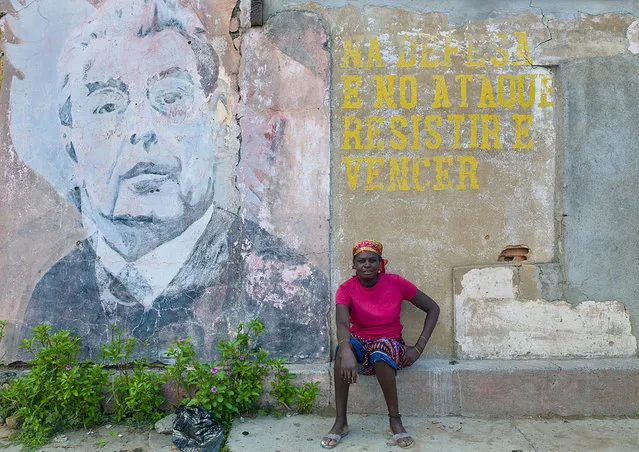
“Old propaganda wall painting with Leonid Brejnev – Bilaiambundo Angola. For years, Angola has been the little sister of Cuba and Russia, and you can still see, if you search well, some propaganda paintings about work, economy, society etc from the 70's... Most of them have been removed or destroyed. But i have seen some Fidel Castro portraits in many places. Even now, the big companies tend to communicate like in a communist country, they glorify the future of the country etc etc.
The funny thing is that this painting is on the wall of a Police station. Police in Angola is a shame, with lots of controls, asking for money, for food, for drinks...
In December 1956, in Portuguese Angola the Angolan Communist Party (PCA) merged with the Party of the United Struggle for Africans in Angola (PLUA) to form the People's Movement for the Liberation of Angola with Viriato da Cruz, the President of the PCA, as Secretary General.
During 1975, before the official Portuguese withdrawal, the civil war in Angola intensifies. In fighting for control of the capital city, Luanda, the MPLA succeeds in driving out both its rivals. UNITA, which claims to enjoy wider popular support than the other groups, argues that Portugal must fulfil its last colonial duty and supervise elections.
But the Portuguese, eager to leave as quickly as possible, abandon the country without formally handing over control to any succeeding government. The MPLA, in possession of the capital and with guaranteed support from the USSR and Cuba, declared itself the government of independent Angola. Agostinho Neto, a distinguished poet who had led the MPLA since 1962, became president.
The Soviet Union supported the MPLA-PT as a liberation movement before independence and formalized its relationship with the MPLAPT government through the Treaty of Friendship and Cooperation and a series of military agreements beginning in 1975. Once it became clear that the MPLA-PT could, with Cuban support, remain in power, the Soviet Union provided economic and technical assistance and granted Angola most-favored-nation status. In 1976 MPLA adopted Marxism-Leninism as the party ideology. It maintained close ties with the Soviet Union and the Communist bloc, establishing socialist economic policies and a one-party state.
For the first decade after independence, trade with communist states was not significant, but in the late 1980s dos Santos sought expanded economic ties with the Soviet Union, China, and Czechoslovakia and other nations of Eastern Europe as the MPLA-PT attempted to diversify its economic relations and reduce its dependence on the West. In October 1986, Angola signed a cooperative agreement with the Council for Mutual Economic Assistance (Comecon), a consortium dedicated to economic cooperation among the Soviet Union and its allies. As part of the Comecon agreement, Soviet support for Angolan educational and training programs was increased. In 1987 approximately 1,800 Angolan students attended institutions of higher education in the Soviet Union. The Soviet Union also provided about 100 lecturers to Agostinho Neto University in Luanda, and a variety of Soviet-sponsored training programs operated in Angola, most with Cuban instructors. Approximately 4,000 Angolans studied at the international school on Cuba's renowned Isle of Youth. More Angolan students were scheduled to attend the Union of Young Communists' School in Havana in 1989.
Cuba's presence in Angola was more complex than it appeared to outsiders who viewed the Soviet Union's Third World clients as little more than surrogates for their powerful patron. The initiative in placing Cuban troops in Angola in the mid-1970s was taken by President Fidel Castro as part of his avowed mission of "Cuban internationalism." Facing widespread unemployment at home, young Cuban men were urged to serve in the military overseas as their patriotic duty, and veterans enjoyed great prestige on their return. Castro also raised the possibility of a Cuban resettlement scheme in southern Angola, and several hundred Cubans received Angolan citizenship during the 1980s. Cuban immigration increased sharply in 1988. In addition to military support, Cuba provided Angola with several thousand teachers, physicians, and civilian laborers for construction, agriculture, and industry. Angolan dependence on Cuban medical personnel was so complete that during the 1980s Spanish became known as the language of medicine”. (Photo and comments by Eric Lafforgue)
The funny thing is that this painting is on the wall of a Police station. Police in Angola is a shame, with lots of controls, asking for money, for food, for drinks...
In December 1956, in Portuguese Angola the Angolan Communist Party (PCA) merged with the Party of the United Struggle for Africans in Angola (PLUA) to form the People's Movement for the Liberation of Angola with Viriato da Cruz, the President of the PCA, as Secretary General.
During 1975, before the official Portuguese withdrawal, the civil war in Angola intensifies. In fighting for control of the capital city, Luanda, the MPLA succeeds in driving out both its rivals. UNITA, which claims to enjoy wider popular support than the other groups, argues that Portugal must fulfil its last colonial duty and supervise elections.
But the Portuguese, eager to leave as quickly as possible, abandon the country without formally handing over control to any succeeding government. The MPLA, in possession of the capital and with guaranteed support from the USSR and Cuba, declared itself the government of independent Angola. Agostinho Neto, a distinguished poet who had led the MPLA since 1962, became president.
The Soviet Union supported the MPLA-PT as a liberation movement before independence and formalized its relationship with the MPLAPT government through the Treaty of Friendship and Cooperation and a series of military agreements beginning in 1975. Once it became clear that the MPLA-PT could, with Cuban support, remain in power, the Soviet Union provided economic and technical assistance and granted Angola most-favored-nation status. In 1976 MPLA adopted Marxism-Leninism as the party ideology. It maintained close ties with the Soviet Union and the Communist bloc, establishing socialist economic policies and a one-party state.
For the first decade after independence, trade with communist states was not significant, but in the late 1980s dos Santos sought expanded economic ties with the Soviet Union, China, and Czechoslovakia and other nations of Eastern Europe as the MPLA-PT attempted to diversify its economic relations and reduce its dependence on the West. In October 1986, Angola signed a cooperative agreement with the Council for Mutual Economic Assistance (Comecon), a consortium dedicated to economic cooperation among the Soviet Union and its allies. As part of the Comecon agreement, Soviet support for Angolan educational and training programs was increased. In 1987 approximately 1,800 Angolan students attended institutions of higher education in the Soviet Union. The Soviet Union also provided about 100 lecturers to Agostinho Neto University in Luanda, and a variety of Soviet-sponsored training programs operated in Angola, most with Cuban instructors. Approximately 4,000 Angolans studied at the international school on Cuba's renowned Isle of Youth. More Angolan students were scheduled to attend the Union of Young Communists' School in Havana in 1989.
Cuba's presence in Angola was more complex than it appeared to outsiders who viewed the Soviet Union's Third World clients as little more than surrogates for their powerful patron. The initiative in placing Cuban troops in Angola in the mid-1970s was taken by President Fidel Castro as part of his avowed mission of "Cuban internationalism." Facing widespread unemployment at home, young Cuban men were urged to serve in the military overseas as their patriotic duty, and veterans enjoyed great prestige on their return. Castro also raised the possibility of a Cuban resettlement scheme in southern Angola, and several hundred Cubans received Angolan citizenship during the 1980s. Cuban immigration increased sharply in 1988. In addition to military support, Cuba provided Angola with several thousand teachers, physicians, and civilian laborers for construction, agriculture, and industry. Angolan dependence on Cuban medical personnel was so complete that during the 1980s Spanish became known as the language of medicine”. (Photo and comments by Eric Lafforgue)
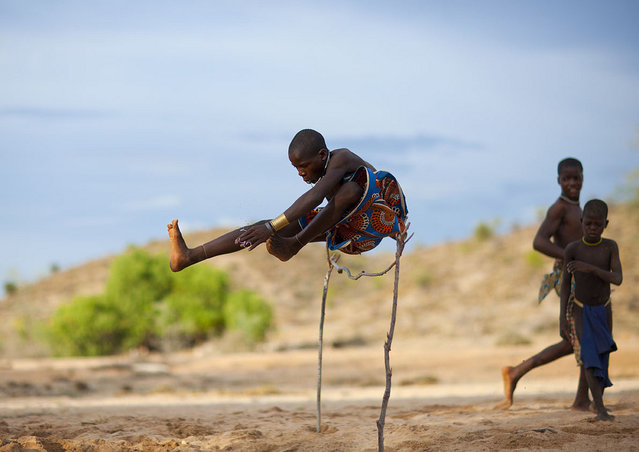
“Mucubal kid jumping – Angola. In Mucubal tribe, when you live in the bush, no PSP, no WII, no TV, no Radio..so the game the kids like the most is to jump over a wood hurdle. They have to touch a stone in front of the hurdle before jumping.
Mucubal (also called Mucubai, Mucabale, Mugubale) people are a subgroup of the Herero ethnic group, which means they are bantu speaking, and are supposed to have come from Kenya and to be related with Massais.
They are semi nomadic pastoralists living of cattle raising and agriculture. They live in a large area between the slopes of Chela Mounts in the north, and River Cunene to the south, where they are believed to have stopped during the Herero migration, about 300 years ago.
Mucubal have some very specific customs and traditions. They only are interested in cattle and do not care of the rest of the world outside of the bush. Mucubals are not allowed to mention people’s name in public, except their parent’s one, and children’s name in general. A married couple is not allowed to talk to each other in public, as long as the wife hasn’t had children. They only can speak to each other in private. Girls have their upper teeth sharpened and lower ones removed. In order to convince young girls to have their lower teeth removed, old men make them believe, that their teeth leave their mouth during the night, to go in a hole dug to relieve themselves and return in their mouth covered with excrement. The family structure and organization is also very specific. The father has the authority and is the head of the family, although the matrilineal descent is considered more important, as they inherit throught the mother's family. For example the son of the Soba -chieftain of the village-’s sister is the heir of the Soba. It is possible to be disowned by their father's family but not by their mother's because for them this link is sacred. The maternal uncle has to provide his nephew with an ox, called Remussungo. However a father provides his son with an ox, called Hupa. Mucubal can only get married with an outsider of the clan, although it cannot be with a member of another tribe like a Himba for example. Marriages of convenience are the rule most of the time. The fiancée is presented to her future husband during the Fico ceremony, when she is fourteen or less. This ceremony consists in a party with the two families during which presents are offered. The couple has to wait a few more years before consummating the marriage in the centre of the village.
Mucubal men can have several wives and are also allowed to sell their wife, if they don’t get along with her or even if they want to earn money, as a woman can be worth 2 cows, which is about 2000 euros and represents a lot of money. For a first marriage a woman can even be worth 3 or 4 cows.
Their nomadic lifestyle based on cycles, between nomadism and stays in the same places (where they settle their villages), accounts for their religious customs and the funerary rites they follow. Mucubal people believe in a God called Huku, Klaunga, Ndyambi. They also worship their ancestors' spirits called Oyo Handi and Ovi huku, which are considered inferior to their supreme divinity. Divination is very important in their culture. They use talismans and amulets to protect their herds or prevent adultery. Nevertheless Mucubal are not afraid of death. Funerals can last several days or weeks. They decorate their graves with cattle horns. The number of cows sacrificed are in relation with the importance of the deceased. This shows the importance of cattle in their culture. Cattle is only killed on special occasions, as Mucubal usually don’t eat meat but rather corn (when they manage to grow some), eggs, milk and chicken.
They don’t eat any fish because according to the legend, one of their chieftains was brought to the sea by the portuguese and never came back. So they think that fish kills men”. (Photo and comments by Eric Lafforgue)
Mucubal (also called Mucubai, Mucabale, Mugubale) people are a subgroup of the Herero ethnic group, which means they are bantu speaking, and are supposed to have come from Kenya and to be related with Massais.
They are semi nomadic pastoralists living of cattle raising and agriculture. They live in a large area between the slopes of Chela Mounts in the north, and River Cunene to the south, where they are believed to have stopped during the Herero migration, about 300 years ago.
Mucubal have some very specific customs and traditions. They only are interested in cattle and do not care of the rest of the world outside of the bush. Mucubals are not allowed to mention people’s name in public, except their parent’s one, and children’s name in general. A married couple is not allowed to talk to each other in public, as long as the wife hasn’t had children. They only can speak to each other in private. Girls have their upper teeth sharpened and lower ones removed. In order to convince young girls to have their lower teeth removed, old men make them believe, that their teeth leave their mouth during the night, to go in a hole dug to relieve themselves and return in their mouth covered with excrement. The family structure and organization is also very specific. The father has the authority and is the head of the family, although the matrilineal descent is considered more important, as they inherit throught the mother's family. For example the son of the Soba -chieftain of the village-’s sister is the heir of the Soba. It is possible to be disowned by their father's family but not by their mother's because for them this link is sacred. The maternal uncle has to provide his nephew with an ox, called Remussungo. However a father provides his son with an ox, called Hupa. Mucubal can only get married with an outsider of the clan, although it cannot be with a member of another tribe like a Himba for example. Marriages of convenience are the rule most of the time. The fiancée is presented to her future husband during the Fico ceremony, when she is fourteen or less. This ceremony consists in a party with the two families during which presents are offered. The couple has to wait a few more years before consummating the marriage in the centre of the village.
Mucubal men can have several wives and are also allowed to sell their wife, if they don’t get along with her or even if they want to earn money, as a woman can be worth 2 cows, which is about 2000 euros and represents a lot of money. For a first marriage a woman can even be worth 3 or 4 cows.
Their nomadic lifestyle based on cycles, between nomadism and stays in the same places (where they settle their villages), accounts for their religious customs and the funerary rites they follow. Mucubal people believe in a God called Huku, Klaunga, Ndyambi. They also worship their ancestors' spirits called Oyo Handi and Ovi huku, which are considered inferior to their supreme divinity. Divination is very important in their culture. They use talismans and amulets to protect their herds or prevent adultery. Nevertheless Mucubal are not afraid of death. Funerals can last several days or weeks. They decorate their graves with cattle horns. The number of cows sacrificed are in relation with the importance of the deceased. This shows the importance of cattle in their culture. Cattle is only killed on special occasions, as Mucubal usually don’t eat meat but rather corn (when they manage to grow some), eggs, milk and chicken.
They don’t eat any fish because according to the legend, one of their chieftains was brought to the sea by the portuguese and never came back. So they think that fish kills men”. (Photo and comments by Eric Lafforgue)

“Playing with light in Mwila tribe – Angola. Funny time when i started to play with the flash! Mumuhuila women are serious drinkers, and sometimes, they even drink more than the men! Some can in the camp at 7 in the morning to have a look at the wine bottles..and finished them!”. (Photo and comments by Eric Lafforgue)
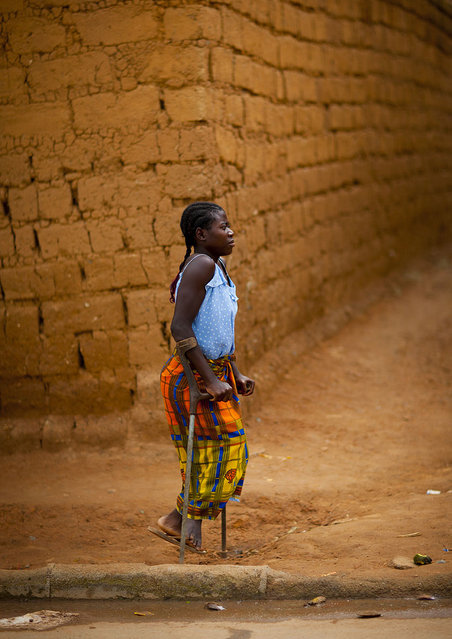
“30 years of civil war – Angola. I expected to see lot of wounded people, but i saw not so many in Angola. I saw lots of people having polio. it seems that the civil war destroyed the health public programms, and so many young people were not vaccinated against Polio”... (Photo and comments by Eric Lafforgue)
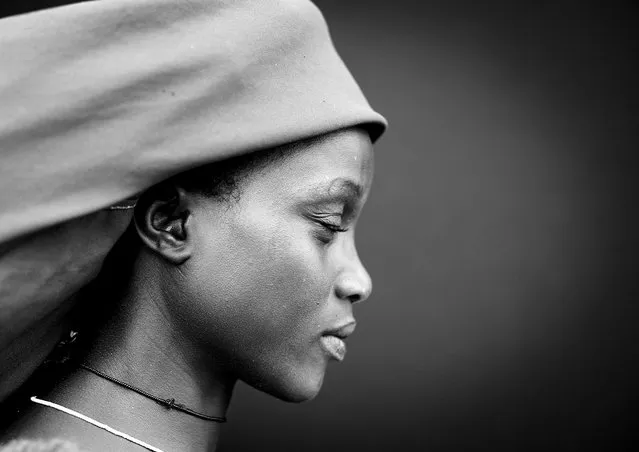
“Mucubal profile woman – Angola. She lives with her 2 kids and another boy, the son of her brother who died. They all live under a little house made of trees. Impossible for everybody to be under the roof at the same time, so some might sleep under the stars... She invited me to share a lunch. She boiled a kind of Cranberries. To know if the water is hot enough, she put her hand inside. Once it really hurts, she throw the Cranberries inside. After 1 minute, they eat them. It is like eating some red pepper!”. (Photo and comments by Eric Lafforgue)
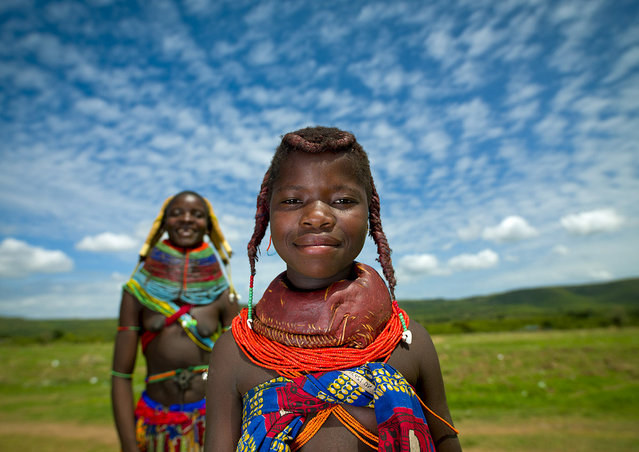
“Mumuhuila tribe girls – Angola. This little girl from the Mumuhuila tribe live near Chibia, in the south of Angola. She wears the traditional hairstyle and the big necklace. The necklace shows if she is teen or not. She is still a child as the necklace is red.
On the hair, she wears the traditional hairstyle, made with a mix of trunk, oil and dried cow dung. Those girls live dressed like that, they were not dressed for me.
In the back, her sister, who is already married, and so who wears the big beads necklace”. (Photo and comments by Eric Lafforgue)
On the hair, she wears the traditional hairstyle, made with a mix of trunk, oil and dried cow dung. Those girls live dressed like that, they were not dressed for me.
In the back, her sister, who is already married, and so who wears the big beads necklace”. (Photo and comments by Eric Lafforgue)
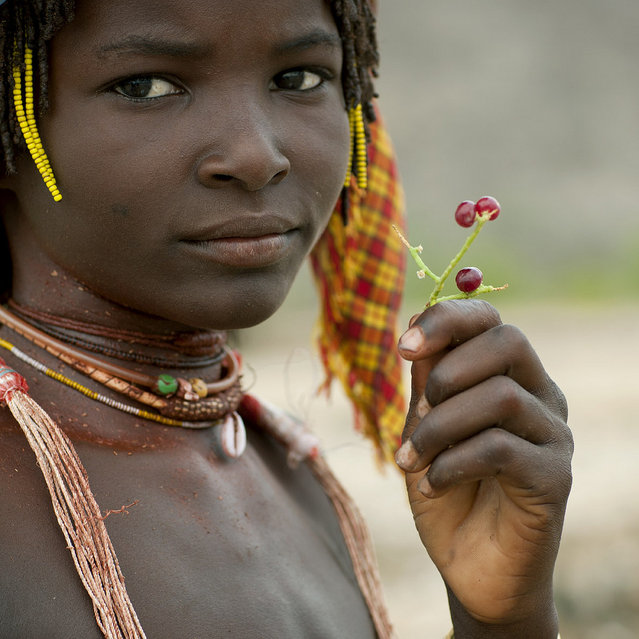
“Mucubal tribe girl – Angola. Mucubal like to eat this kind of cranberries. They boil them. To know if the water is hot enough, she put her hand inside. Once it really hurts, she throw the Cranberries inside. After 1 minute, they eat them. It is like eating some red pepper!”. (Photo and comments by Eric Lafforgue)
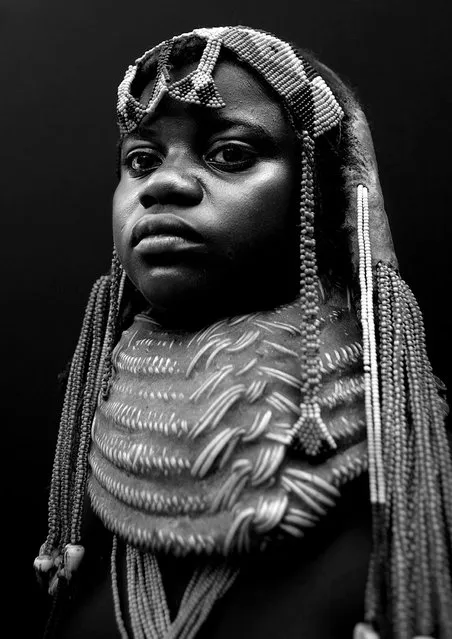
“Mumuhuila girl with huge necklace – Angola. By the kind of necklace the girl wears, you can say if she is a kid, a teen, a women ready to marry a man, or a married woman.
This one has the huge necklace that she needs to keep from puberty until she marries a man. It may takes 4 years.Then she'll wear a giant neckalce beads.
Mumuhuila have a strange costum. Usually, i ask the name of the people for my pictures. In Mumuhuila, you must not ask the name of the people, and people won't tell their name inf ront of others. Quiet surprizing and disturbing!
The hairstyle is made of dried cow dungs, herbs, trunks, oil and fat. The number of big dreadlocks has a meaning: 3 dreadlocks means there is a dead people in the family. 4 to 6 dreadlocks is the normal style”. (Photo and comments by Eric Lafforgue)
This one has the huge necklace that she needs to keep from puberty until she marries a man. It may takes 4 years.Then she'll wear a giant neckalce beads.
Mumuhuila have a strange costum. Usually, i ask the name of the people for my pictures. In Mumuhuila, you must not ask the name of the people, and people won't tell their name inf ront of others. Quiet surprizing and disturbing!
The hairstyle is made of dried cow dungs, herbs, trunks, oil and fat. The number of big dreadlocks has a meaning: 3 dreadlocks means there is a dead people in the family. 4 to 6 dreadlocks is the normal style”. (Photo and comments by Eric Lafforgue)
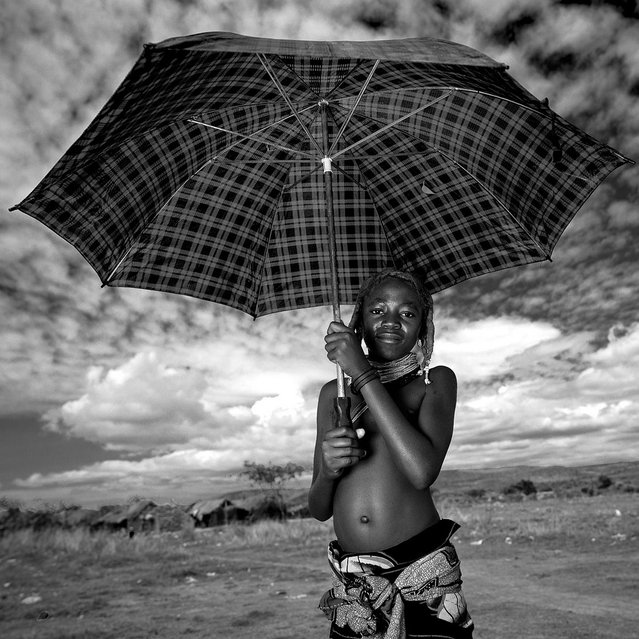
“Mumuhuila girl with umbrella – Angola. The weather was so hot! She made her traditionnal hairstyle made of cow dungs, herbs, oil, and fat, to come to the weekly market in Hale. A way to show the other people the beauty of the clan. It works!
Mumuhuila have a strange costum. Usually, i ask the name of the people for my pictures. In Mumuhuila, you must not ask the name of the people, and people won't tell their name inf ront of others. Quiet surprizing and disturbing!
The number of big dreadlocks has a meaning: 3 dreadlocks means there is a dead people in the family. 4 to 6 dreadlocks is the normal style”. (Photo and comments by Eric Lafforgue)
Mumuhuila have a strange costum. Usually, i ask the name of the people for my pictures. In Mumuhuila, you must not ask the name of the people, and people won't tell their name inf ront of others. Quiet surprizing and disturbing!
The number of big dreadlocks has a meaning: 3 dreadlocks means there is a dead people in the family. 4 to 6 dreadlocks is the normal style”. (Photo and comments by Eric Lafforgue)
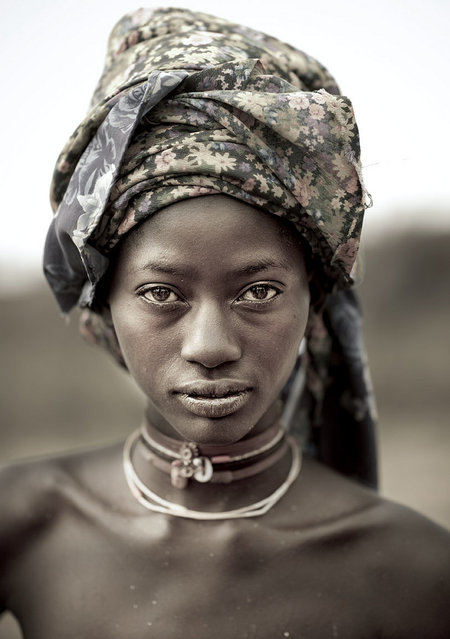
“Mucubal tribe beauty – Angola. A Mucabal girl without the giant headwear! Mucubal (also called Mucubai, Mucabale, Mugubale) people are a subgroup of the Herero ethnic group, which means they are bantu speaking, and are supposed to have come from Kenya and to be related with Massais”. (Photo and comments by Eric Lafforgue)
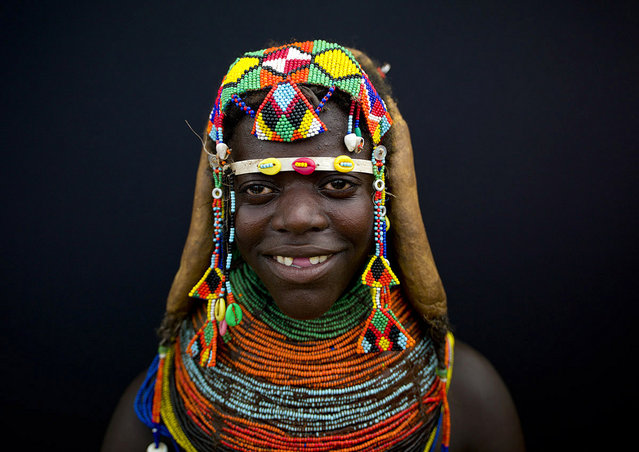
“Happiness of a young wife – Mumuhuila Angola. She smiles as she is happy: she is newly married, and wears her brand new beads necklace. She also shows you her Mumuhuila smile, with teeth removed or cut”. (Photo and comments by Eric Lafforgue)
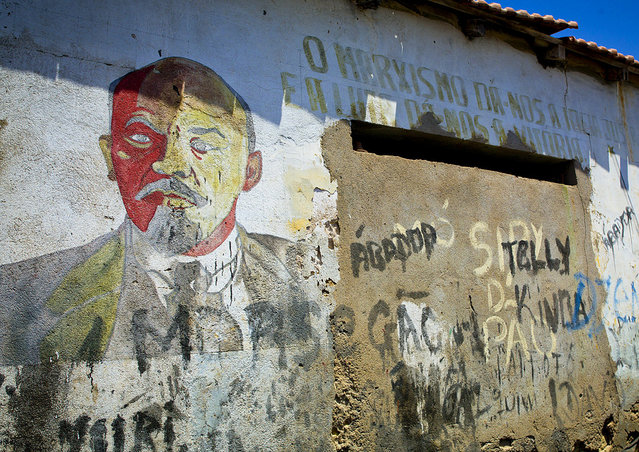
“Lenin portrait in Namibe – Angola. In Namibe, in an old garage, i saw this painted walls, with 70's communist slogans and the portrait of Lenine. Very few can still be seen i Angola. At this time, Cuba and USSR were supporting MPLA to fight UNITA party , supported by USA and South Africa”. (Photo and comments by Eric Lafforgue)
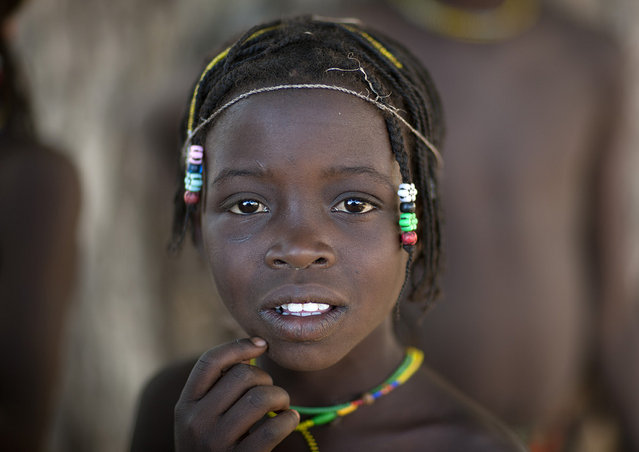
“Mucawana tribe girl – Angola. Muhacaona (Mucawana) tribe girl. The haircut is made with a mix of dried cow dung, fat, and herbs for the fragrance”. (Photo and comments by Eric Lafforgue)
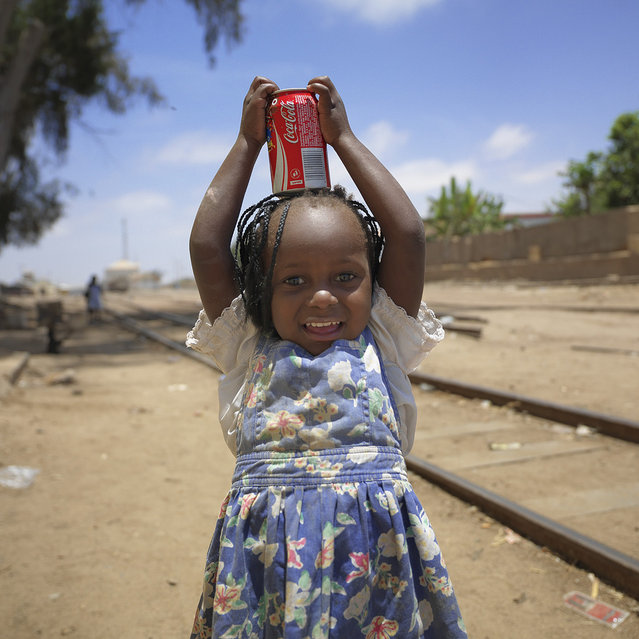
“Bringing back home the essential – Namibe Angola. This little girl was carrying on her head a Coca Cola bottle, back from the shop, like all the girls and women do in Angola”. (Photo and comments by Eric Lafforgue)
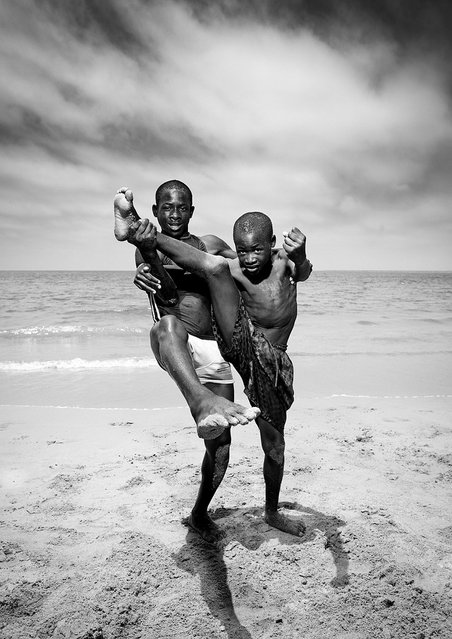
“Capoeira training on Namibe beach – Angola. Kids and teens come to the beach in Namibe, on the coast, to train at Capoeira. Great time to make pictures of them, even if the 10 kids all wanted to be on every picture at the same time! They jump, dance, fight, in a very happy mood. But..they don't go to school”... (Photo and comments by Eric Lafforgue)
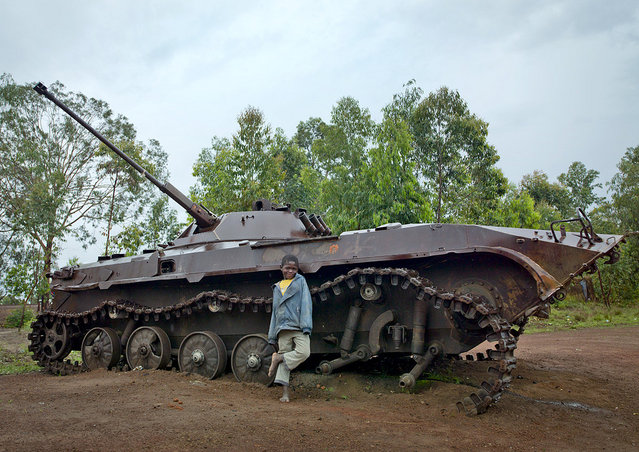
“Souvenir from the civil war – Angola. Hundreds of tanks can still be seen all around Angola, even in town, like in Huambo. And of course, the kids use them as giant toys! Adults use it as a giant bin”... (Photo and comments by Eric Lafforgue)
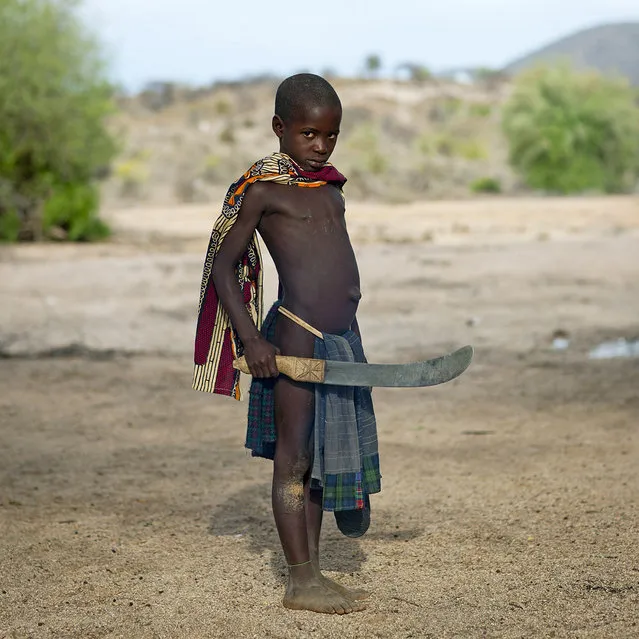
“The smallest you are, the biggest you have.. Mucubal Angola. All the Mucubal men have this big knife called omotungo, at any time of the day. They use it to cut wood, kill scorpions and snakes. It is also a good way to look terrific to the french tourists!”. (Photo and comments by Eric Lafforgue)
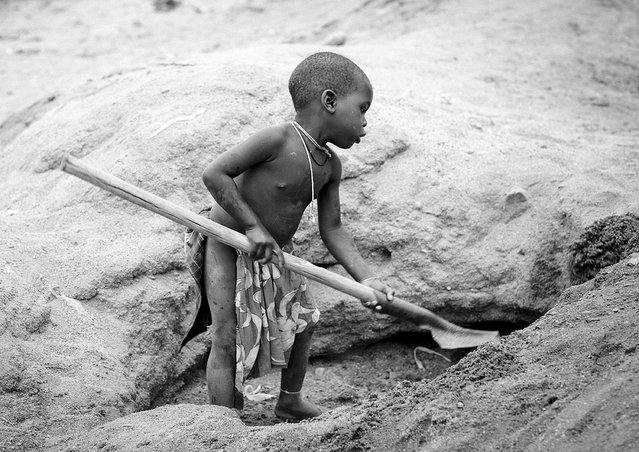
“Mucubal kid digging for water – Angola. Mucubal near Virie grow corn, as they have access to good wells. But the daily work is to dig the well to rech the water which can be 2 or 3 meters deep.This little kid imitates the adults and help them”. (Photo and comments by Eric Lafforgue)
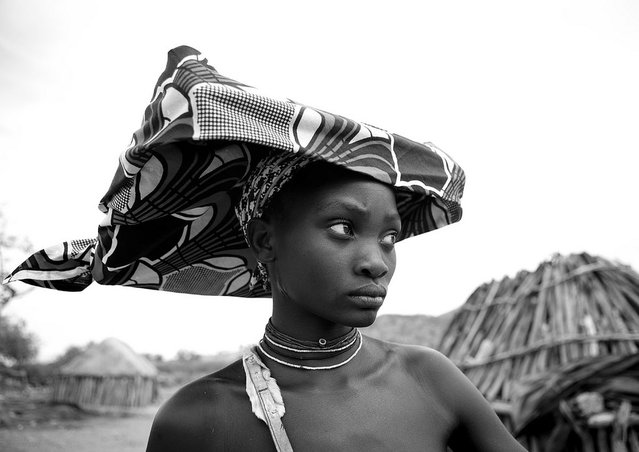
“Mucubal giant hat – Angola. Mucubal (also called Mucubai, Mucabale, Mugubale) people are a subgroup of the Herero ethnic group, which means they are bantu speaking, and are supposed to have come from Kenya and to be related with Massais”. (Photo and comments by Eric Lafforgue)
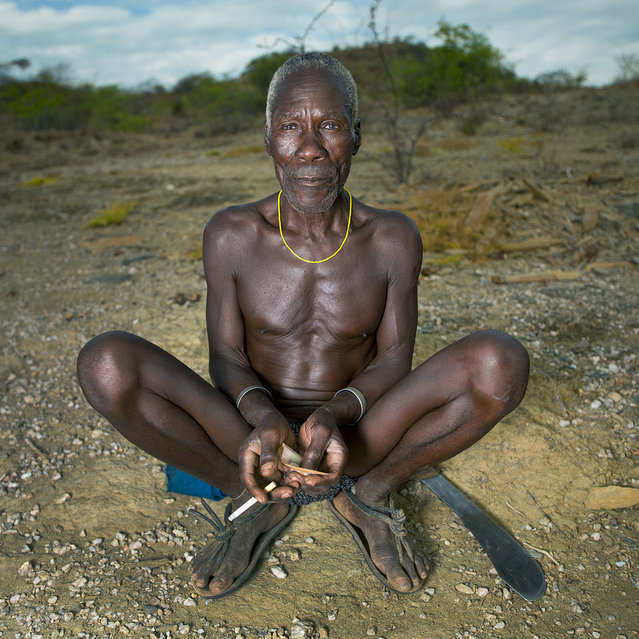
“The man who sold his wife to his friend – Mucubal Angola. This man sold his wife to his best friend. It is possible in Mucubal tribe!
For 2 cows ( a huge price as a cow costs something like 1000 us dollars) In Mucabale tribe, you can buy the wife of someone”. (Photo and comments by Eric Lafforgue)
For 2 cows ( a huge price as a cow costs something like 1000 us dollars) In Mucabale tribe, you can buy the wife of someone”. (Photo and comments by Eric Lafforgue)
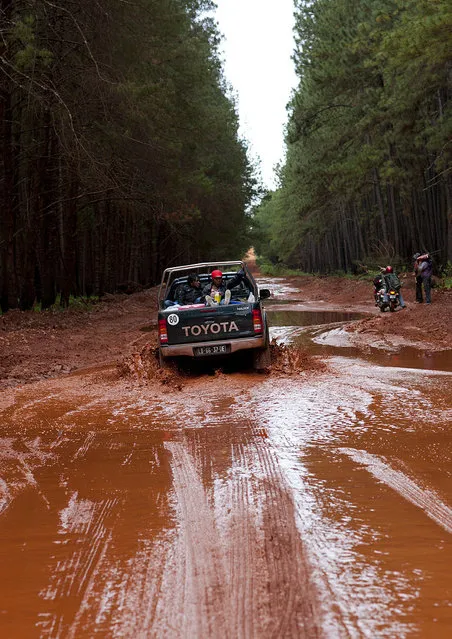
“Is the road good this way? Yes, no problem! As Angola is building many new roads, most of the people in rural areas do not know how the roads are...off roads, concrete, highways, you can have a lot of (bad) surprises...Like this one around Huambo which was supposed to “very good” according to the farmers around!”. (Photo and comments by Eric Lafforgue)
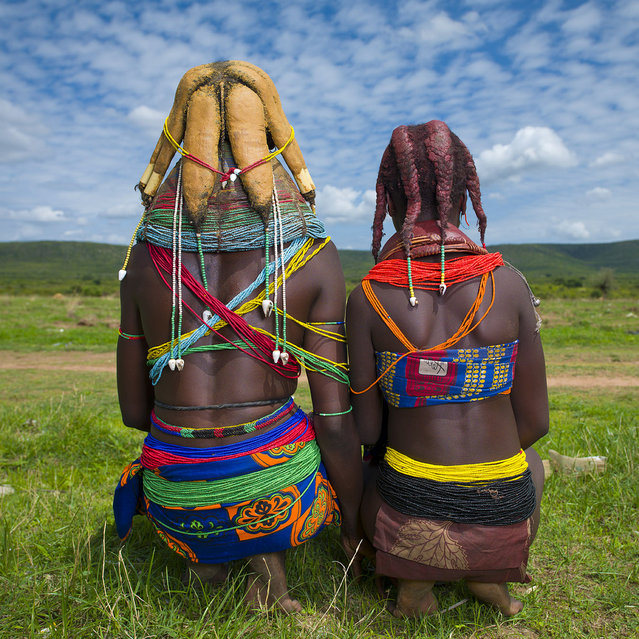
“Mwila tribe women backs – Angola. On the left, she is married , she wears the beads necklaces, and on the right, her sister is not yet married, as she wears the big red necklace”. (Photo and comments by Eric Lafforgue)
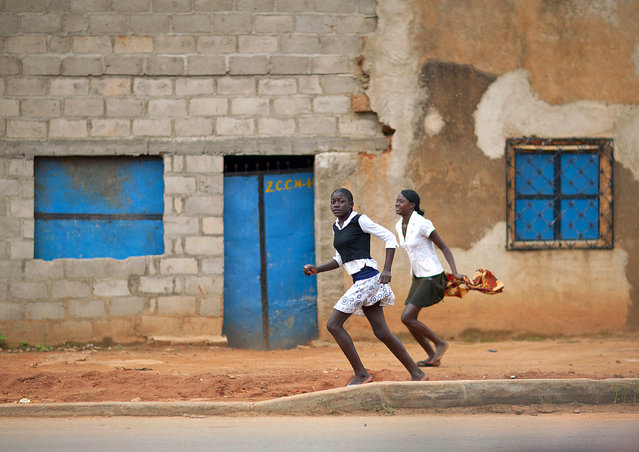
“Late for school in Huambo – Angola”. (Photo and comments by Eric Lafforgue)
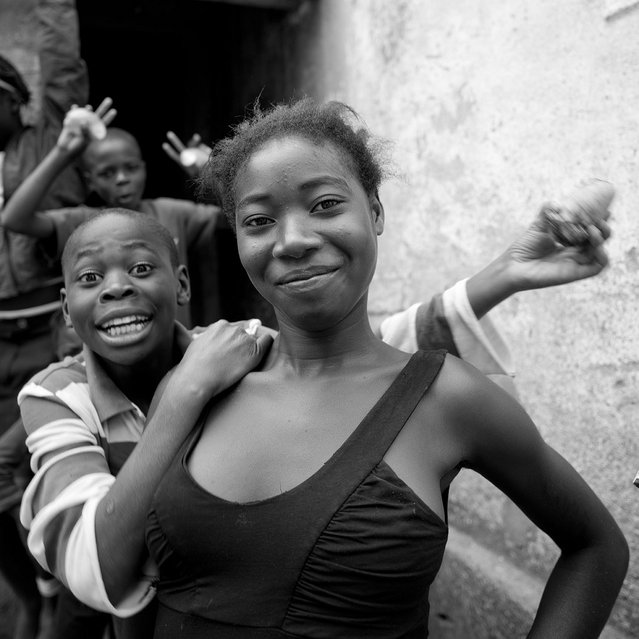
“Girl And Boy Smiling In Caconda, Angola. They smile, but they have a really hard life, in a remote area, after 30 years of civil war”... (Photo and comments by Eric Lafforgue)
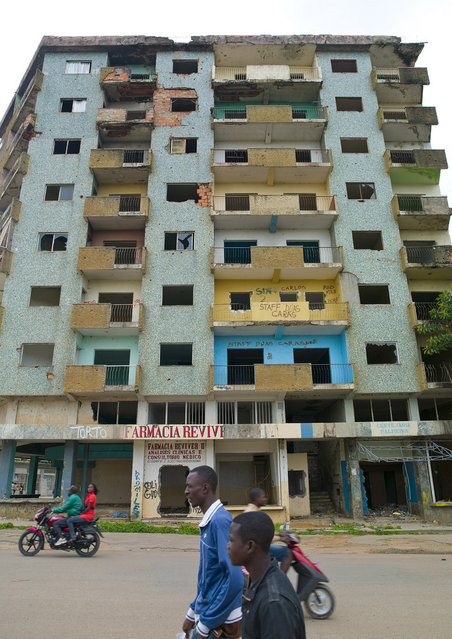
“Flats In Huambo after civil war, Angola, 2010. Huambo’s name comes from Wambu, one of the 14 old Ovimbundu kingdoms of the central Angolan plateau. In 1928 Huambo was renamed Nova Lisboa (New Lisbon, after Lisbon the capital of Portugal), indicating that the colonial administration had the intention of making it the capital of the colony. After the independence from Portugal in 1975, Nova Lisboa was given back its original name. The Angolan Civil War (1975–2002) stopped Angola's and Huambo's development, destroying an important part of its infrastructure. Huambo became the place of hard battles during the bloody civil war between the government and UNITA from independence, as it UNITA headquarters were located in it, until the death of rebel UNITA leader Jonas Savimbi in 2002. The city was besieged, seriously damaged, and its civilians were slaughtered in crowd or fled the city.
The signature of a new cease-fire, after Savimbi’s death brought back tranquility to the Province and set the conditions for the current peace process and the beginning of an era of development. Nowadays the city has a population of about 225,000 inhabitants”. (Photo and comments by Eric Lafforgue)
The signature of a new cease-fire, after Savimbi’s death brought back tranquility to the Province and set the conditions for the current peace process and the beginning of an era of development. Nowadays the city has a population of about 225,000 inhabitants”. (Photo and comments by Eric Lafforgue)
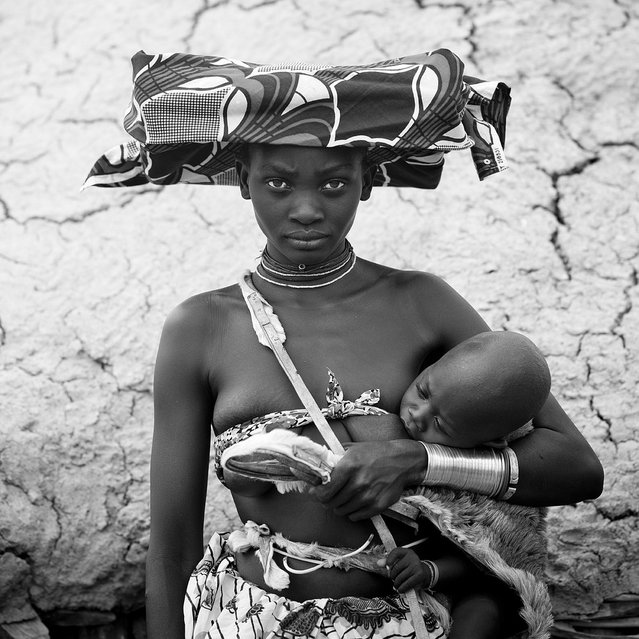
“Mucubal Woman Holding Her Baby, Virie Area, Angola. Mucubal especially women, are famous for the way they dress. The latter wear an original and unique headdress called the Ompota. It is made of a wicker framework, traditionally filled with a bunch of tied cow tails, decorated with buttons, shells, zippers and beads. But tradition is disappearing as some women use barbie dolls boxes to cram their ompota headdress. Women whether they are married or not can wear jewels.
Ornaments like iron anklets, called Othivela, and armlets, called Othingo, are worn by girls as well as adult women. Mucubal women are also famous for the string they have around their breast, called oyonduthi, which is used as a bra. Women use to smoke tobacco (that they keep in a snuffbox called boceta) in pipes called opessi”. (Photo and comments by Eric Lafforgue)
Ornaments like iron anklets, called Othivela, and armlets, called Othingo, are worn by girls as well as adult women. Mucubal women are also famous for the string they have around their breast, called oyonduthi, which is used as a bra. Women use to smoke tobacco (that they keep in a snuffbox called boceta) in pipes called opessi”. (Photo and comments by Eric Lafforgue)
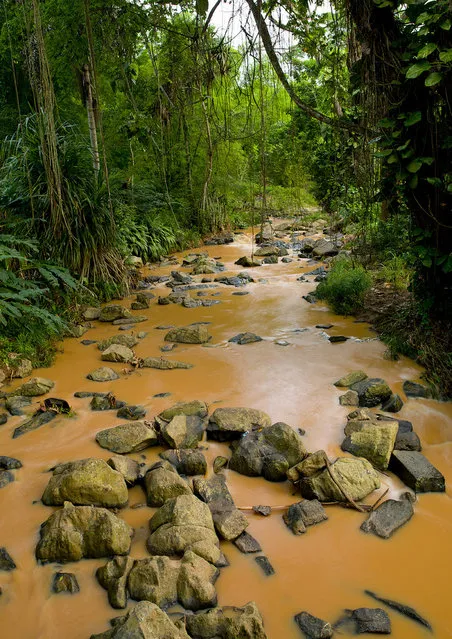
“Muddy River In N Dalatando Botanical Garden, Angola. N'dalatando is a town of Cuanza Norte Province in Angola. It is also the capital of this province. Under portuguese rule the city was called Vila Salazar”. (Photo and comments by Eric Lafforgue)
09 Nov 2012 15:04:00,
post received
0 comments
